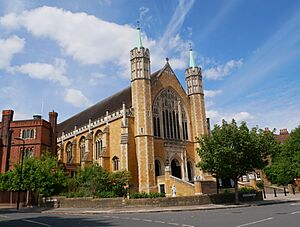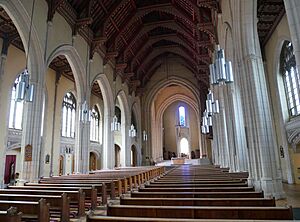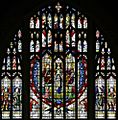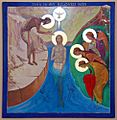Ealing Abbey facts for kids
Quick facts for kids Ealing Abbey |
|
|---|---|
| The Church and Abbey of Saint Benedict of Nursia | |

The Abbey Church – front
|
|
| Lua error in Module:Location_map at line 420: attempt to index field 'wikibase' (a nil value). | |
| OS grid reference | TQ1742781453 |
| Location | Ealing, London |
| Country | England |
| Denomination | Roman Catholic |
| History | |
| Founded | March 1897 |
| Founder(s) | Cardinal Herbert Vaughan |
| Dedication | Saint Benedict of Nursia |
| Architecture | |
| Functional status | Active |
| Heritage designation | Grade II |
| Designated | 19 January 1981 |
| Architect(s) | Frederick Walters |
| Style | Perpendicular Gothic |
| Administration | |
| Deanery | Ealing |
| Archdiocese | Westminster |
| Province | Westminster |
The Abbey of Ealing is a Roman Catholic Benedictine monastery located on Castlebar Hill in Ealing, England. A monastery is a place where monks live and work together. The monks at Ealing Abbey follow the rules of Saint Benedict of Nursia. In 2020, there were fourteen monks living at the Abbey.
Contents
History of Ealing Abbey
The monastery in Ealing started in 1897. It was founded by monks from Downside Abbey. At first, it was a local church in the Archdiocese of Westminster. In 1916, it became a "priory," which is a smaller type of monastery. It became an independent priory in 1947.
In 1955, Pope Pius XII made the building an "abbey." An abbey is a larger and more important monastery led by an abbot.
The Abbey Building and Its Design
The main church building at Ealing Abbey is a special historical building. It was designed by an architect named F A Walters. Parts of the church were finished by 1899, and the monastery was in use by 1905. More sections, like the sanctuary and Lady Chapel, were completed by 1915. The front part of the church was finished by 1934 by Edward John Walters, who was F A Walters' son.
The church was damaged during World War II in 1940. Two bombs hit it, destroying parts like the organ area and the east end. Only two stained glass windows survived, though they were also damaged.
Repairs began in 1957 and were finished by 1962. The church was made bigger, and new sections called transepts were added. More parts, like the Monks Choir and Lady Chapel, were added between 1996 and 1998.
The roof of the main part of the church is called a "hammerbeam" roof. It has painted designs with the letters IHC and SB, which stand for Jesus and Saint Benedict.
The large window at the west end of the church shows the Coronation of the Virgin Mary. It was made by artists named Burlison and Grylls. Another window in the south transept remembers people who died in the world wars. It was made by Ninian Comper and William Bucknall around 1960. It shows a young Risen Christ and saints.
There is also a painting in the church called "Peter's Denial of Christ" by Jusepe de Ribera.
Abbey Activities and Community Life
Parish Life at the Abbey
One of the main things the monks at Ealing Abbey do is run a large local church. This church is called the Abbey Church of Saint Benedict. Both the local church services and the monks' own services happen here.
Music Programs
The Ealing Abbey Choir has boys' and men's voices. They sing at the main Sunday service. The choir was even on the BBC television show Songs of Praise in 2005.
The Abbey also has many music concerts with choirs and organ music. Sometimes, other choirs perform there too.
There is a special choir for people who are not monks, called the Lay Plainchant Choir. They learn and sing traditional church music. This choir practices weekly and sings at a Sunday service once a month. They also visit a local care home to sing for elderly people.
Hospitality and Welcoming Guests
The monks at Ealing Abbey welcome guests to stay at the monastery. These guests can be priests or other men. Guests are invited to join the monks for morning mass and evening prayers. The Abbey has a special house for guests and for people who come for quiet retreats.
St Benedict's School
A big part of the Abbey's work in the past was teaching at St Benedict's School, Ealing. This school was started in 1902. It is an independent day school for boys and, since 2007, also for girls in the older grades. There is also a small nursery for very young children. Since 1987, the school has been led by a headmaster who is not a monk. In 2012, the school became its own charity with a new board of governors. This change allowed the monks to choose other activities to focus on. The Abbey also has connections with a nearby girls' school, St Augustine's Priory, Ealing.
Over the years, there have been serious concerns about the safety of children at St Benedict's School. Investigations led to important changes in the school's leadership and policies. These changes were made to make sure children are protected. For example, in 2013, the Independent Schools Inspectorate said that the care for students at St Benedict's was excellent. In 2018-2019, a large inquiry looked into how Catholic organizations in England and Wales protected children. As a result of these events, the abbot of Ealing Abbey resigned in 2019.
Benedictine Institute for Learning
The monks at Ealing also run the Benedictine Institute. This institute started in 1992. It offers adult education programs, especially in Sacred Liturgy (church services) and Liberal Arts. This includes subjects like theology, and both modern and classical languages, such as Latin. They have a popular Latin summer school every year.
The Benedictine Institute is located in a Victorian house next to the Abbey. It has a library called the St Bede Library. This library has many books for studying theology and liturgy.
The Institute also publishes a magazine called Benedictine Culture twice a year.
Notable Monks of Ealing
Several well-known monks have lived and worked at Ealing Abbey.
Bernard Orchard, who was a biblical scholar (someone who studies the Bible), was a respected monk here.
Between 1933 and 1939, David Knowles, a historian who studied monasteries, lived at Ealing. He did research for his important book, The Monastic Order in England, while he was there. He later became a professor at the University of Cambridge.
Cuthbert Butler also lived at Ealing after he retired as Abbot of Downside in 1922. He stayed until he passed away in 1934. John Main, who taught a type of Christian meditation, was a monk at Ealing from 1959 to 1970 and again from 1974 to 1977. His meditation methods are now used by the World Community for Christian Meditation.
In 2011, a special review of Ealing Abbey was ordered. This review looked at how the Abbey protected people, especially children.
Leaders of Ealing Abbey
The following monks have served as the leader of the Abbey. Before 1955, they were called "Prior," and after 1955, when it became an Abbey, they were called "Abbot."
| Years | Role | Name | Notes |
|---|---|---|---|
| 1916 to 1925 | Prior | Wulstan Pearson | Later became the first Catholic Bishop of Lancaster |
| 1925 to 1935 | Prior | Benedict Kuypers | |
| 1935 to 1938 | Prior | Edward Green | Was Headmaster of Ealing Priory School from 1917 to 1919 |
| 1938 | Prior | Mark Pontifex | |
| 1938 to 1945 | Prior | Stanislaus Chatterton | |
| 1945 to 1946 | Prior | Ambrose Agius | |
| 1946 to 1955 | Prior | Charles Pontifex | Became the first Abbot |
| 1955 to 1956 | Abbot | Charles Pontifex | Resigned after a car accident |
| 1956 to 1967 | Abbot | Rupert Hall | Was Headmaster of Ealing Priory School from 1939 to 1945 |
| 1967 to 1991 | Abbot | Francis Rossiter | |
| 1991 to 2000 | Abbot | Laurence Soper | |
| 2000 to 2019 | Abbot | Martin Shipperlee | Resigned in 2019 |
| 2019 | Abbot | Domingo Taylor |
Gallery














